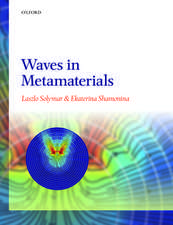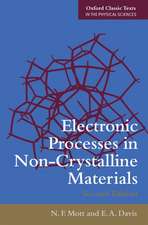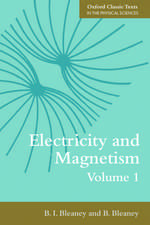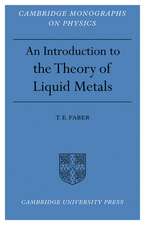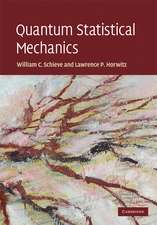Magnetic Properties of Layered Transition Metal Compounds: Physics and Chemistry of Materials with Low-Dimensional Structures, cartea 9
Editat de L.J. de Jonghen Limba Engleză Hardback – 30 apr 1990
| Toate formatele și edițiile | Preț | Express |
|---|---|---|
| Paperback (1) | 1223.55 lei 6-8 săpt. | |
| SPRINGER NETHERLANDS – 22 oct 2011 | 1223.55 lei 6-8 săpt. | |
| Hardback (1) | 1229.73 lei 6-8 săpt. | |
| SPRINGER NETHERLANDS – 30 apr 1990 | 1229.73 lei 6-8 săpt. |
Din seria Physics and Chemistry of Materials with Low-Dimensional Structures
- 18%
 Preț: 1830.49 lei
Preț: 1830.49 lei -
 Preț: 398.15 lei
Preț: 398.15 lei - 18%
 Preț: 1232.26 lei
Preț: 1232.26 lei - 18%
 Preț: 1223.55 lei
Preț: 1223.55 lei - 18%
 Preț: 1225.16 lei
Preț: 1225.16 lei - 18%
 Preț: 1225.31 lei
Preț: 1225.31 lei - 18%
 Preț: 1833.33 lei
Preț: 1833.33 lei - 18%
 Preț: 1230.53 lei
Preț: 1230.53 lei - 18%
 Preț: 1228.47 lei
Preț: 1228.47 lei -
 Preț: 402.98 lei
Preț: 402.98 lei - 18%
 Preț: 1231.01 lei
Preț: 1231.01 lei -
 Preț: 386.99 lei
Preț: 386.99 lei - 18%
 Preț: 952.57 lei
Preț: 952.57 lei - 18%
 Preț: 1227.99 lei
Preț: 1227.99 lei - 18%
 Preț: 962.18 lei
Preț: 962.18 lei - 15%
 Preț: 586.37 lei
Preț: 586.37 lei
Preț: 1229.73 lei
Preț vechi: 1499.66 lei
-18% Nou
Puncte Express: 1845
Preț estimativ în valută:
235.30€ • 246.34$ • 194.70£
235.30€ • 246.34$ • 194.70£
Carte tipărită la comandă
Livrare economică 08-22 aprilie
Preluare comenzi: 021 569.72.76
Specificații
ISBN-13: 9780792302384
ISBN-10: 0792302389
Pagini: 422
Ilustrații: XIV, 422 p.
Dimensiuni: 155 x 235 x 25 mm
Greutate: 0.79 kg
Ediția:1990
Editura: SPRINGER NETHERLANDS
Colecția Springer
Seria Physics and Chemistry of Materials with Low-Dimensional Structures
Locul publicării:Dordrecht, Netherlands
ISBN-10: 0792302389
Pagini: 422
Ilustrații: XIV, 422 p.
Dimensiuni: 155 x 235 x 25 mm
Greutate: 0.79 kg
Ediția:1990
Editura: SPRINGER NETHERLANDS
Colecția Springer
Seria Physics and Chemistry of Materials with Low-Dimensional Structures
Locul publicării:Dordrecht, Netherlands
Public țintă
ResearchCuprins
to Low-Dimensional Magnetic Systems.- 1. Experimental realizations of 2-d magnetic systems.- 2. Magnetic model Hamiltonians.- 3. Survey of the predicted magnetic behaviour.- 4. Lattice- and spin-dimensionality crossovers in quasi 2-d magnetic systems.- 5. Magnetic and nonmagnetic impurity doping in quasi 2-d magnets.- References.- Theory of Two-Dimensional Magnets.- 1. Introduction.- 2. Ising magnets.- 2.1. Ising model. Excitations and phase transitions.- 2.2. Onsager solution.- 2.3. Critical exponents and scaling.- 2.4. Dual transformation. Order and disorder.- 3. Planar magnets.- 3.1. XY model.- 3.2. Excitations.- 3.3. Scaling and correlations.- 3.4. Phase transition.- 3.5. Magnetic vortices as a Coulomb gas.- 3.6. Relationships with other models.- 3.7. Planar antiferromagnets.- 4. Heisenberg magnets.- 4.1. Heisenberg model and real magnets.- 4.2. Renormailzation of the temperature.- 4.3. Heisenberg ferromagnets in an external magnetic field.- 4.4. Excitations of the 2-d Heisenberg model.- 4.5. Dipolar interactions.- 5. Experimental layered magnets.- 5.1. Ising layered magnets. ANNNI model: application to CeSb and CeBi.- 5.2. Layered planar magnets.- 5.3. Layered Heisenberg magnets.- 6. Dynamics of 2-d magnets.- 6.1. Equations of motion.- 6.2. Spin-wave dynamics.- 6.3. Spin-diffusion dynamics.- 6.4. Dynamics of localized excitations.- 6.5. Resonant paramagnetic cxcitation of vortex pairs.- 6.6. Summary.- Acknowledgement.- References.- Application of High- and Low-Temperature Series Expansions to Two-Dimensional Magnetic Systems.- 1. Introduction.- 1.1. Series expansions.- 1.2. Methods applied in series analysis.- 1.2.1. Ratio methods.- 1.2.2. Padé approximant methods.- 1.2.3. Other methods of series analysis.- 2. Series expansions and predictions for the 2-d Isingmodel.- 2.1. Spin 1/2 model with nearest neighbours only (simple 2-d lattices).- 2.1.1. High-temperature series.- 2.1.2. Low-temperature series.- 2.1.3. Properties in nonzero parallel field.- 2.1.4. Properties in nonzero perpendicular field.- 2.2. Ising model with general S.- 2.3. Other series for I (1/2).- 2.3.1. Restricted dimensionality systems.- 2.3.2. Further-neighbour interactions.- 2.3.3. Crossover from 2-d to 3-d behaviour.- 3. Series expansions and predictions for the Heisenberg model.- 3.1. Series for S = 1/2, arbitrary S and S = ?.- 3.1.1. Properties at nonzero field.- 3.2. Other series for the Heisenberg model.- 3.2.1. Restricted dimensionality.- 3.2.2. Further-neighbour interactions.- 3.2.3. Crossover from 2-d to 3-d behaviour.- 4. Series expansion in the X Y and Ising—Heisenberg models.- 4.1. Series for the 2-d XY model.- 4.2. Series for the 2-d Ising-Heisenberg model.- 5. Applications to magnetic systems.- 5.1. Ising model.- 5.2. Heisenberg model.- 5.2.1. Spin 1/2.- 5.2.2. Spin 1.- 5.2.3. Spin 3/2 and spin 2.- 5.2.4. Spin 5/2.- 5.2.5. Restricted dimensionality.- 5.3. XY and Ising-Heisenberg models.- Acknowledgements.- References.- Spin Waves in Two-Dimensional Magnetic Systems: Theory and Applications.- 1. Introduction.- 2. Magnetic structures and spin Hamiltonians.- 3. Spin wave theory of model systems.- 4. Dispersion relation.- 5. Thermodynamic properties.- 6. Impurities in antiferromagnets.- References.- Neutron Scattering Experiments on Two-Dimensional Heisenberg and Ising Magnets.- 1. Introduction.- 2. 2-d systems with Ising and Heisenberg interactions.- 2.1. K2CoF4: a 2-d Ising system.- 2.2. K2FeF4: a 2-d planar antiferromagnet.- 2.3. K2MnF4 and K2NiF4: weakly anisotropic Heisenberg magnets.- 2.4. Rb2CrCl4: a planar Heisenberg ferromagnet withsmall anisotropy.- 2.5. K2CuF4: a planar Heisenberg ferromagnet.- 3. 2-d random magnetic systems.- 3.1. Phase transitions and critical phenomena.- 3.2. Excitations.- 3.3. Random field effects.- 3.4. Relaxation front 2-d to 3-d order.- 3.5. Competing anisotropics and interactions.- 4. Triangular lattice antiferromagnet (TALAF).- 4.1. Fluctuations.- 4.2. An additional degree of freedom.- 4.3. Perturbation.- 4.4. Quantum effect RbFeCl3 and CsFeCl3 VX2 (X = Cl, Br, I) AMX2 (A = Li, Na, K; M = 3d metal ion; X = O, S, Se).- References.- Phase Transitions in Quasi Two-Dimensional Planar Magnets.- 1. Introduction.- 2. Phase transition and excitations in the 2-d XY model.- 3. Crystallographic properties of BaM2(X)4)2 compounds.- 4. Magnetic properties of BaNi2(PO4)2.- 4.1. Static properties.- 4.2. Dynamic properties.- 4.3. Critical properties.- 5. Magnetic properties of BaCo2(AsO4)2.- 5.1. Static properties.- 5.2. Magnetic phase diagrams.- 5.3. Dynamic properties.- 6. Magnetic properties of BaNi2(AsO4)2.- 6.1. Static properties.- 6.2. Dynamic properties.- 7. Magnetic properties of BaCo2(PO4)2.- 8. Other experimental realizations of the 2-d planar model.- 8.1. K2CuF4.- 8.2. NiCl2 and CoCL2 graphite intercalated compounds NiCl2-GIC CoCl2-GIC.- 9. Concluding remarks.- Acknowledgement.- References.- Spin Dynamics in the Paramagnetic Regime: NMR and EPR in Two-Dimensional Magnets.- 1. Introduction.- 1.1. Dynamics of the 2-spin correlation functions.- 1.2. Nuclear magnetic resonance (NMR).- 1.3. Electron paramagnetic resonance (EPR).- 2. General formalism.- 2.1. Diffusion and dimensionality.- 2.2. Cut-off and EPR linewidth.- 3. EPR spectrum.- 3.1. Diffusion of 4-spin correlation functions.- 3.2. Secular contribution D0.- 3.3. Nonsecular contributions.- 3.4. Satellite line.- 4. Experiments on quasi 2-d Heisenberg magnets.- 4.1. NMR experiments.- 4.2. EPR experiments.- 4.2.1. Angular dependence of linewidth.- 4.2.2. Frequency dependence of magic angle linewidth.- 4.2.3. Dynamic shift.- 4.2.4. Lineshape of the main line.- 4.2.5. Satellite lines at half resonance field.- 5. Critical dynamcis.- 5.1. Critical behaviour of the NMR line.- 5.1.1. Isotropic regime.- 5.1.2. Anisotropic regime.- 5.1.3. Experiments.- 5.2. Critical behaviour of the EPR linewidth.- 5.2.1. Ferromagnets.- 5.2.2. Antiferromagnets.- 5.3. AC susceptibility.- 6. Conclusions.- References.- Field-Induced Phenomena in Two-Dimensional Weakly Anisotropic Heisenberg Antiferromagnets.- 1. Introduction.- 2. Effective, field-dependent anisotropies.- 3. The phase diagram.- 4. Random fields and domain walls (solitons).- 5. The spin flop transition.- 6. The bicritical point.- 7. Concluding remarks.- Acknowledgements.- References.- Index of Names.- Index of Chemical Compounds.- Index of Subjects.


